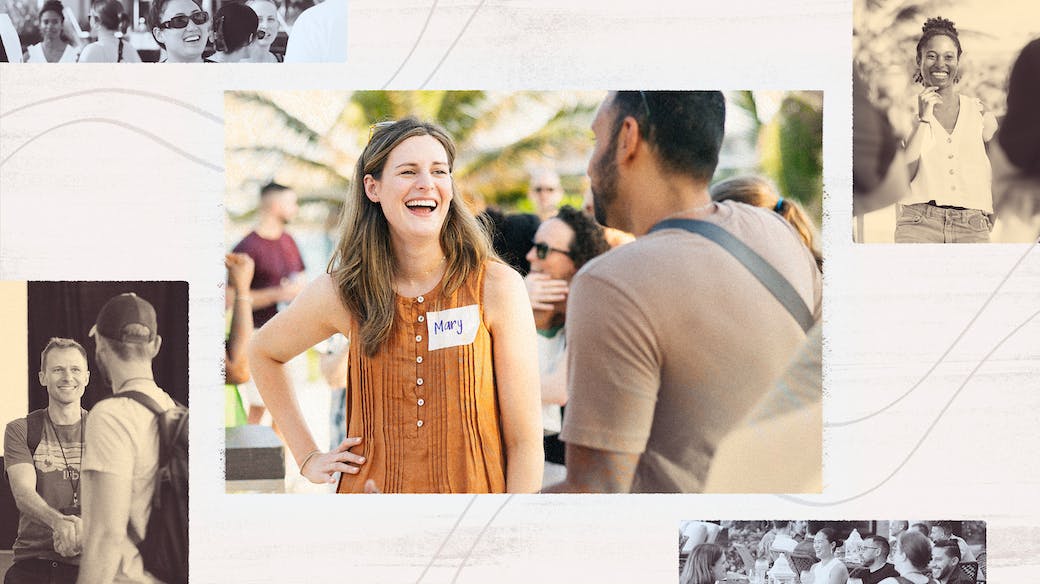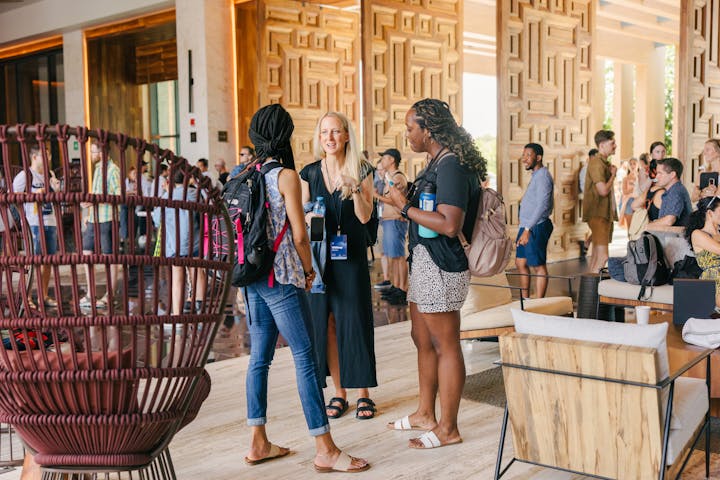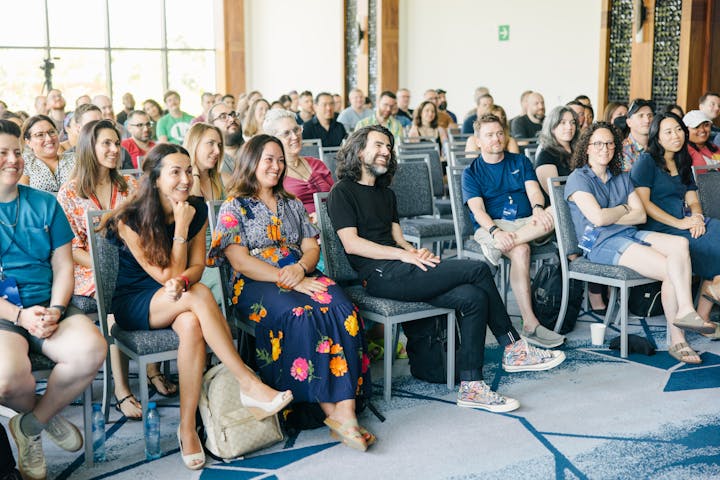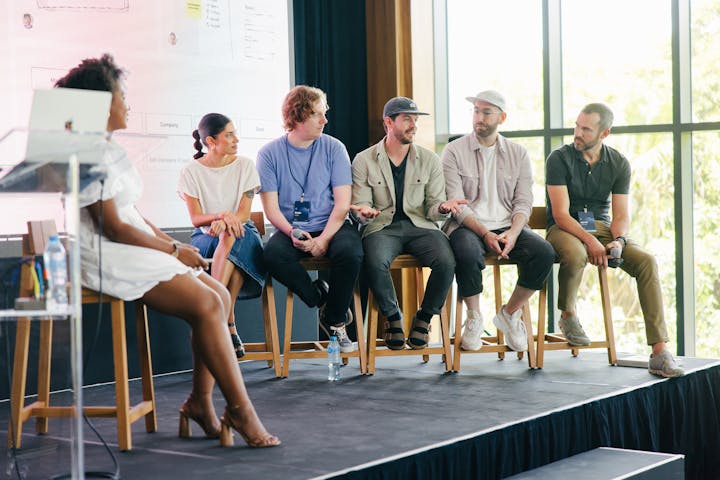How to Plan for Connection at Your Remote-company Retreat


At Help Scout, our semi-annual all-company retreat is a pillar of our company culture and a much-loved tradition for our remote-first team. Coming together in person for several days sparks new connections, nurtures existing relationships, and fuels collaboration.
But the retreat is much more than that. The magic of the gathering also exists in the undefinable, intangible gift of personal connections — of deep conversations and shared laughs and casual chats. There is a current of joy and possibility in the air during retreat, a unique energy that we feel as we converge around company values, goals, and the warmth of the culture we’re building together.
For Help Scout’s CEO and co-founder, Nick Francis, the twice-yearly gathering of the globally distributed team is vital. “Without a doubt, retreat week is the most important week of the year for this company,” he said. “Since we work remotely, retreats are really the only time we have to break bread with our colleagues, build relationships, and talk about the future of our business, all in one place. For me, personally, it’s a magical experience. I always leave the retreat buzzing from the ideas and perspectives I hear throughout the week.”

Why connection matters: In person hits deeper
Help Scout has now hosted 13 all-company retreats, and while the size of the team and the specific challenges and opportunities of the business have evolved over the years, meeting one another face to face and sharing experiences has always been the driver. During the first gathering, in Provincetown, Massachusetts, the entire team — 11 employees at that point — celebrated the company’s new profitability, collaborated around future goals, cooked and shared meals, and held the first of what has remained a cherished tradition: karaoke night.
In 2015, at the retreat in Steamboat, Colorado, having just raised capital for the first time, the retreat was an opportunity to celebrate and plan. “The time spent figuring out how to make the most of the funds raised, together, was an incredible opportunity,” Nick said. “The time we spent dreaming about the business at that point had a profound impact on the business we have today.”
Since those first, homegrown versions, the retreat experience has expanded — in size, scope, and geography. The Help Scout team has gathered in stunning locales, including Lisbon, Portugal; Austin, Texas; Park City, Utah; Dublin, Ireland; and Cancun, Mexico. But while the scale of the team and the logistics of travel have grown, personal connections have remained at the heart of retreat.
“It’s always so special to see people meet for the first time. I love watching those moments happen,” said Leah Knobler, Help Scout’s VP of people (who helped plan the early retreats and has attended 11 of the 13 events). “And as the week goes on, to watch everyone spend time together and laugh and share meals is magical. I like to walk around and hear bits and pieces of convos at different tables and to soak it all in.”

Engineer coach Corey Nilan, who attended the most recent retreat in May 2023 in Tulum, Mexico, agreed. “There's something about spending face-to-face time getting to know a teammate that hits deeper,” she said. “It creates so much more social capital within the organization, which is critical for working together well and moving forward with ambitious goals.”
Help Scout’s customer service content lead, Mat Patterson, said the long-term relationships that develop over multiple retreats are a gift: “Retreats accelerate interpersonal understanding and plant seeds that can be nurtured from home.” That interpersonal understanding covered a pretty wide array of topics in Mat’s conversations this time around in Tulum. “An incomplete list of things I learned something new about on retreat: Buddhism, Polish history, AI, comparative serving sizes of the world, Eurovision, data analytics, design exploration, whiskey, pricing and packaging. Tunisian family life. Highland cows.”

Another aspect of interpersonal understanding only available through in-person events: “Knowing how tall someone really is — that’s when you're really connecting,” joked Eli Overbey, VP of Revenue Operations. “You feel like you know someone over Zoom, but then they show up at 6’5”, and you realize you had it all wrong. You need those in-person times to chat, fix problems more quickly, and get an accurate understanding of who you’d want to be on a volleyball team with.”
All joking aside, these reflections on the value of time and space for in-person connection offer a glimpse into how deeply this experience matters to our team. While we’re still working on finding just the right balance in retreat planning — time spent informally and in structured activities, the best groupings for meals, and the right mix of team-building activities — we know that continuing to prioritize connection will shape the experience of future retreats, too.
Interested in learning more about company retreat ideas and how we focus on connection as we craft our retreats? Read on for a few helpful tips and learnings from our experience.

What we’ve learned: 3 tips to help you plan a company retreat around connection
1. Seek expert support for the details so you can focus on the big picture
Given the increasingly complex travel and logistics required for the now more than 100 team members participating in recent years, Help Scout works with corporate retreat experts at Moniker Partners to plan and execute our all-company retreats.
Myrtle Ossai, Help Scout’s people experience specialist, worked with Moniker’s team in planning the 2023 retreat and said the expertise Moniker offers was essential. “With Moniker running all of the logistics, the People team was able to focus on making sure the content and team-building activities were aligned with our goal of creating connections across the team,” she said. The professional support offered another, equally important benefit: “The fact that Moniker was handling so many of the things that come up daily during a retreat when you’re working with such a large number of travelers meant that our internal team could enjoy the retreat ourselves.”

2. Build a company retreat agenda that includes plenty of space for organic connection
When you’re gathering your entire team, there may be an understandable temptation to fill the hours with presentations, planning, structured team-building activities, and innovation sessions. And while all of these company retreat ideas can be positive, holding space for informal meetups and conversations among team members is important if connection is your priority. After every Help Scout retreat, we receive feedback that highlights the value of these unplanned conversations to our team.
In practical terms, when shaping a retreat schedule, this might look like:
Adding blocks of open time into the calendar in the morning and evening and between planned group sessions so folks can mingle or have a bit of personal space.
Creating both structured meet-up options (e.g., ERGs, optional sport or social hours) and free blocks of time for organic gatherings.
Offering some seated meals to connect specific teams or cross-functional groups and some open seating meals.
Specifically noting “leisure time” on the group calendar at various times to ensure folks know that the time is theirs to plan (or not).
However you craft an agenda to meet your team’s needs, know that the chance to connect will be appreciated. For account executive Kyle Long, the chance to get to know his teammates as humans — not just colleagues — was the most meaningful aspect of his recent retreat experience. “We had some amazing sessions and pitch competitions during the retreat, but the poolside and dinner conversations, not about work but about people’s lives and families, were by far and away my highlight and what I look forward to each year.”

3. Be intentional about structured time
Having set aside plenty of time (and clear direction) for folks to get together on their own, make sure that the time that you do plan for all-company participation also helps build connections.
At Help Scout retreats, we do this in a few important ways. First, the opening session generally brings us together around company values and priorities, which connects us as teammates working toward shared goals. In Tulum, opening talks by Nick and other leaders around company values, customer stories, and design innovation set the tone and highlighted our common objectives.
Second, everyone who attends the retreat participates in whole-company support power hours. During these hour-long blocks, folks from across the company hop in to respond to support queue conversations. This shared experience of connecting around our product and supporting our customers team so they can also enjoy the retreat connects us all to the company and to one another.
Third, when it comes to planning excursions and activities, we offer a wide variety of options to ensure everyone can choose to engage with teammates in a setting in which they’re comfortable. In Tulum, options included a cruiser bike tour, a catamaran excursion, mocktail lessons, and Mezcal tasting. These opportunities to connect through a shared experience are another retreat highlight for many Help Scout folks.
CFO Shawna Fisher, who participated in the catamaran excursion in Tulum — on a day that proved a bit windier than expected — said the activity created a lasting bond with her teammates. “That wild catamaran ride inspired so many laughs and screams. It’s a fond memory I now have with 40 of my teammates,” she said. “Those moments give you a bond to carry forward when you return home and return to work.”

A bond to carry forward
There’s no question that connecting with teammates is one of the greatest gifts of the retreat experience for our team, which reflects Help Scout’s culture: People who work for our company are open and welcoming and curious. We appreciate and respect one another. We’re grateful to be contributing to a values-driven, people-first business, and we can’t wait for the next chance to get together. For our team, retreat is the spark that continues to fuel our work and the relationships that drive our company forward.
The Supportive Weekly: A newsletter for people who want to deliver exceptional customer service.
